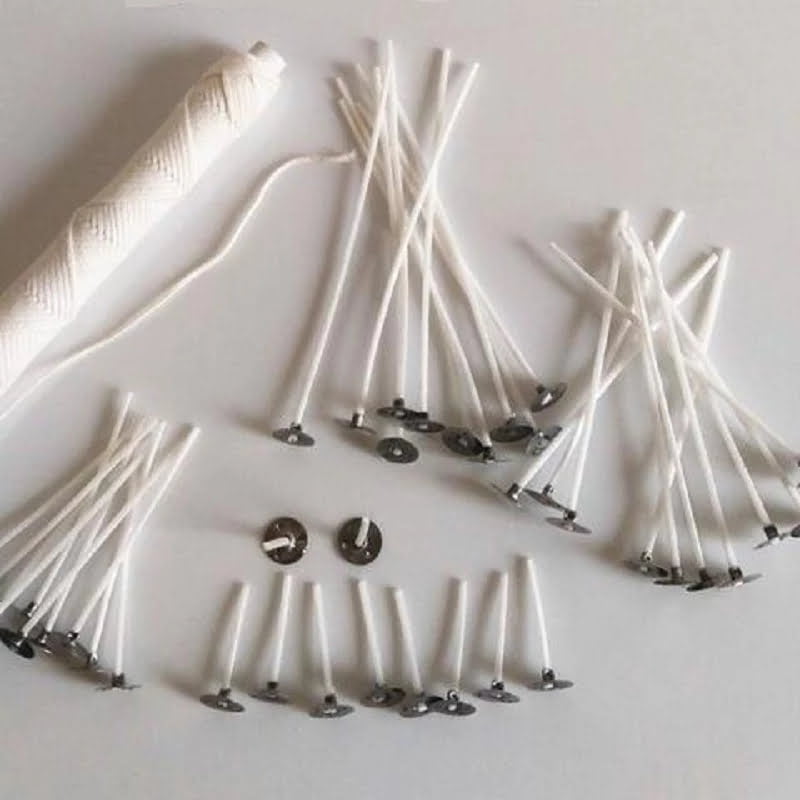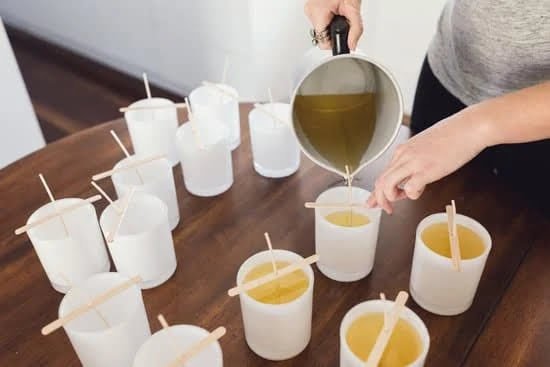Candle making is a popular hobby and art, allowing individuals to create their own beautiful and fragrant candles. One crucial aspect of successful candle making is using quality wax. In this article, we will explore how to make wax for candle making, including an overview of different wax types like beeswax, soy wax, and paraffin wax. We will also delve into the benefits and possibilities of DIY wax making, as well as provide a detailed checklist for gathering essential ingredients.
When it comes to candle making, the choice of wax plays a significant role in determining the overall quality of the final product. The type of wax used affects various factors such as burn time, scent throw, and appearance. Beeswax, soy wax, and paraffin wax are three commonly used options that each have their own unique qualities.
With DIY wax making gaining popularity among candle enthusiasts, it allows for greater control over the entire process. Making your own wax opens up exciting possibilities for customization. Whether you want to experiment with different scents or colors or simply prefer knowing exactly what goes into your candles, learning how to make your own wax can be a rewarding experience.
Before diving into the step-by-step guides on how to make beeswax, soy wax, and paraffin wax at home, it is essential to gather all the necessary ingredients and equipment. Having a detailed checklist ensures that you have everything you need for successful homemade wax creation.
In the following sections of this article, we will provide comprehensive instructions on how to make each type of wax from scratch. Additionally, we will offer troubleshooting tips for common challenges that may arise during the process. By the end of this article, you’ll be equipped with valuable knowledge on how to create high-quality homemade waxes for your candle-making endeavors.
Understanding Different Wax Types
Beeswax, soy wax, and paraffin wax are three popular choices when it comes to making candles. Each type of wax has its own unique characteristics and benefits. Understanding the differences between them will help you make an informed decision when selecting a wax for your candle making project.
Beeswax is a natural wax that is produced by bees. It has been used for centuries because of its high melting point, which makes it ideal for creating long-lasting candles. Beeswax candles also have a pleasant aroma and produce a warm, golden glow when lit. Additionally, beeswax is known to emit negative ions that can help purify the air in your home.
Soy wax, on the other hand, is made from soybean oil and is a popular choice among environmentally conscious individuals. Soy wax candles burn cleaner and produce less soot compared to traditional paraffin candles. They also have a longer burning time and provide more fragrance throw, meaning that they release scent more efficiently.
Paraffin wax is the most commonly used type of wax in commercial candle production due to its affordability and versatility. It is derived from petroleum and undergoes various refining processes to remove impurities. Paraffin candles provide a strong scent throw and come in a wide range of colors and shapes. However, it’s important to note that paraffin candles may release harmful toxins into the air when burned.
In summary, each type of wax has its own advantages and disadvantages. When choosing a wax for your candle making project, consider factors such as burn time, scent throw, eco-friendliness, and personal preferences. Experimenting with different types of waxes will allow you to discover the perfect balance between aesthetics, performance, and safety for your homemade candles.
| Wax Type | Advantages | Disadvantages |
|---|---|---|
| Beeswax | High melting point, long-lasting, pleasant aroma, air-purifying | Higher cost, limited availability |
| Soy wax | Burns cleaner, longer burning time, stronger scent throw | May be more expensive than paraffin wax |
| Paraffin wax | Affordable, versatile, strong scent throw, variety of colors and shapes | Potential release of harmful toxins when burned |
DIY Wax Making
Exploring the benefits and possibilities of DIY wax making can be an exciting and rewarding experience for candle enthusiasts. By creating your own wax, you have greater control over the quality, ingredients, and customization options of your candles. Here, we will delve deeper into the advantages of making your own wax and discuss the endless possibilities it offers.
One of the key benefits of DIY wax making is the ability to craft candles that are free from harmful chemicals and additives. Commercially available waxes often contain additives such as UV inhibitors, stearic acid, or fragrance enhancers. Making your own wax allows you to use natural ingredients, ensuring a cleaner burn with fewer toxins released into the air.
Another advantage is the opportunity for customization. When you create your own wax, you can experiment with different combinations and proportions of ingredients to achieve unique textures, scents, or colors. Whether you prefer a smooth soy wax or a rustic beeswax texture, DIY allows you to cater to your preferences.
Furthermore, making your own wax opens up a world of creative opportunities. You can add dried flowers or herbs to create visually stunning candles with natural scents. For those who enjoy experimenting with scent blends, DIY allows for endless possibilities in creating unique fragrances that reflect your personal style and mood.
To embark on this journey of DIY wax making, there are several essential ingredients you’ll need to gather. From measuring tools to essential oils and dyes for customization, having everything ready before starting the process is crucial for smooth execution. Below is a detailed checklist:
- Double boiler or a heat-resistant container.
- Wax flakes (such as beeswax, soy wax, or paraffin).
- Thermometer.
- Stirring utensil (preferably stainless steel).
- Essential oils or fragrance oils.
- Colorants (liquid dye or dye chips).
- Candle wicks.
- Wick stickers or adhesive dots.
- Heat-resistant containers or molds.
- Measuring tools (scale, measuring cup, or weighing spoon).
With these ingredients ready, you can now move onto the step-by-step guide of making your desired wax for candle making. Whether you choose to explore beeswax, soy wax, or paraffin wax, each section will provide detailed instructions on the process. Through this DIY approach, you’ll have full control over the quality and customization of your candles, while enjoying the creative journey along the way.
Gathering the Essential Ingredients
To successfully make your own wax at home for candle making, it is important to gather all the essential ingredients and equipment beforehand. This detailed checklist will help you ensure that you have everything you need to create high-quality wax.
- Wax: The first and most important ingredient for making wax is, of course, the wax itself. The type of wax you choose will depend on your preferences and the specific qualities you want in your candles. Popular options include beeswax, soy wax, and paraffin wax. Each type has its own unique characteristics, so be sure to choose the one that best suits your needs.
- Additives: Depending on the type of wax you are making, there may be certain additives that can enhance its performance or appearance. For example, some people add stearic acid to paraffin wax to increase its hardness and opacity. Color dyes can also be added to create vibrant candles, while fragrance oils can be used to add a pleasant scent.
- Wicks: A crucial component of any candle, wicks are responsible for carrying the flame and ensuring a steady burn. Cotton wicks are commonly used in homemade candles as they are readily available and provide a consistent flame. Be sure to choose wicks that are appropriate for the diameter of your candle jars.
- Containers: If you plan on making container candles, it’s important to have suitable containers on hand before starting the process. Glass jars or tins are popular choices as they provide a safe and heat-resistant environment for the burning candle. Ensure that your chosen containers are clean and free from any cracks or defects.
- 5.Equipment: In addition to the ingredients mentioned above, there are several pieces of equipment that will make the process of making wax easier and more efficient.
These include a double boiler or a Melting Pot specifically designed for candle making (or makeshift using a heatproof container placed in a larger pot), a thermometer to monitor the wax temperature accurately, a stirring tool (such as a wooden spoon or a dedicated candle-making stirrer), and a scale to measure the ingredients precisely.
By having all the necessary ingredients and equipment ready, you can ensure that your wax making process goes smoothly and that you are well-prepared for creating beautiful homemade candles. Taking the time to gather everything beforehand will also allow you to focus on the creative aspects of candle making without any unnecessary interruptions.
| Essential Ingredients | Essential Equipment |
|---|---|
| Wax (Beeswax, Soy Wax, Paraffin Wax) | Double boiler or Melting Pot |
| Additives (Stearic acid, color dyes, fragrance oils) | Thermometer |
| Wicks | Stirring tool (wooden spoon or candle-making stirrer) |
| Containers (glass jars or tins) | Scale |
Step-by-Step Guide
Beeswax is a popular choice for candle making due to its natural properties and pleasant scent. Making your own beeswax for candle making is a rewarding process that allows you to have full control over the quality and purity of the wax. In this step-by-step guide, we will walk you through the process of making beeswax for candle making.
Gathering the Materials
Before you begin making beeswax, gather all the necessary materials and tools. You will need raw beeswax, which can be purchased from beekeepers or online suppliers. Additionally, you will need a double boiler or a heat-resistant container, a thermometer, cheesecloth or a fine mesh strainer, and clean containers for storing the melted wax.
Preparing the Beeswax
- Start by breaking down the raw beeswax into small pieces. This can be done by using a sharp knife or grating it with a cheese grater. The smaller the pieces, the easier it will melt.
- Next, place the grated beeswax in a double boiler or heat-resistant container. If using a heat-resistant container, set it inside a larger pot filled with water to create a makeshift double boiler.
- Slowly heat the beeswax over low to medium heat until it completely melts. It is important to monitor the temperature using a thermometer to prevent overheating and potential damage to the wax.
- Once melted, remove any impurities or debris from the liquid wax by pouring it through cheesecloth or straining it with a fine mesh strainer into another clean container.
- Prepare your candle molds or containers by greasing them lightly with nonstick cooking spray or lining them with parchment paper.
- Carefully pour the melted wax into your prepared molds or containers, leaving some space at the top for the wick.
- Allow the wax to cool and solidify completely. This may take a few hours, depending on the size of your candles and the ambient temperature.
- Once the wax is fully cooled and solidified, trim the wick to your desired length and your homemade beeswax candles are ready to be used or gifted.
Pouring and Cooling
By following these step-by-step instructions, you can easily make beeswax for candle making at home. Experiment with different fragrances and dyes to create unique candles that suit your personal preferences or gift them to loved ones for special occasions. Beeswax candles not only emit a warm and inviting glow but also provide numerous health benefits, making them a popular choice among candle enthusiasts.
Step-by-Step Guide
Soy wax is a popular choice for candle making due to its natural and environmentally-friendly properties. It is derived from soybean oil, which is renewable and biodegradable. Making your own soy wax at home allows you to have complete control over the ingredients and ensures a high-quality product. Follow this step-by-step guide to make soy wax for candle making:
Gather the Necessary Ingredients
Before getting started, gather all the essential ingredients for making soy wax. You will need:
- Soy flakes: Obtain pure soy flakes from a reputable supplier. The quantity depends on how much wax you want to make.
- Fragrance oil: Choose a fragrance oil that is designed for candle making. The amount of fragrance oil needed will depend on the desired strength of scent.
- Dyes (optional): If you want colored candles, choose dye chips or liquid dyes specifically made for candle making.
- Double boiler: This will be used to melt the soy flakes gently without direct heat.
- Wax thermometer: A crucial tool to ensure proper temperature control throughout the process.
Melt the Soy Flakes
Start by filling the bottom part of a double boiler with water and bring it to a simmer. Place the top pot or container in position, ensuring it fits securely and does not touch the water directly. Add the desired amount of soy flakes into the top pot, adjusting according to how much wax you want to make.
Allow the soy flakes to melt completely while stirring occasionally with a heat-resistant utensil. Pay close attention to avoid overheating, as excessive heat can degrade the quality of the wax.
Add Fragrance Oil and Dye (Optional)
Once all the soy flakes have melted into a smooth liquid, remove it from heat and let it cool slightly until it reaches around 130°F (54°C). At this temperature, add your chosen fragrance oil and dye, if desired. Stir well to distribute the fragrance and color evenly throughout the wax.
It is essential to work efficiently during this step, as the soy wax will begin to thicken as it cools. Ensure all additions are mixed thoroughly before pouring the wax into candle containers.
Making your own soy wax for candle making allows you to create personalized and unique candles while being mindful of the ingredients used. By following these simple steps and experimenting with different fragrances and dyes, you can achieve beautiful and eco-friendly soy candles that will enhance any space.
Step-by-Step Guide
Paraffin wax is a popular choice for candle making due to its affordability and accessibility. Although it is derived from petroleum, paraffin wax can be made at home with simple ingredients and equipment. Follow this step-by-step guide to create your own paraffin wax for candle making:
Materials Needed
- Microcrystalline wax
- Stearic acid
- Colorants (optional)
- Fragrance oils (optional)
- Candle wick
- Candle mold or container
- Double boiler or heat-resistant container and pot
- Thermometer
- Spatula or spoon for stirring
Step 1: Prepare the Workspace
Choose a clean and well-ventilated area for your candle-making process. Place newspaper or a large plastic sheet on the surface to protect it from any spills or stains. Gather all the materials in one place to ensure easy access during the melting and pouring stages.
Step 2: Measure the Ingredients
For every pound of paraffin wax, use about 1/8 cup of microcrystalline wax and 2-4 tablespoons of stearic acid. These ratios may vary based on personal preferences and desired results. If you wish to add colorants or fragrance oils, measure them as per their specific instructions.
Step 3: Melt the Wax
Fill a double boiler with water and bring it to a simmer over medium heat. Place the microcrystalline wax in a heat-resistant container within the double boiler. Stir occasionally until it completely melts. Gradually add in the paraffin wax while stirring continuously until both waxes are fully blended together.
Step 4: Add Stearic Acid
Once the wax mixture has melted, slowly introduce the stearic acid while stirring gently. Continue to stir until the stearic acid is completely incorporated into the wax blend.
Step 5: Optional Additives
If you wish to add colorants or fragrance oils to your paraffin wax, now is the time to do so. Follow the instructions provided with your chosen additives and blend them into the wax mixture thoroughly.
Step 6: Cooling and Pouring
Allow the wax mixture to cool slightly before pouring it into your candle mold or container. Place the candle wick in the center of your mold, ensuring it stands straight without touching the sides. Carefully pour the melted paraffin wax into the mold, leaving some room at the top.
Step 7: Let It Set
Allow the candle to cool and solidify completely, which usually takes a few hours. Avoid disturbing or moving it during this time as it may cause imperfections in the final product.
Making paraffin wax for candle making at home can be a rewarding experience and allows customization of colors and fragrance options. Always observe safety precautions while handling hot wax, such as using gloves and keeping children and pets away from your workspace. With practice and experimentation, you can achieve perfectly crafted candles using homemade paraffin wax.
Troubleshooting and Tips
In conclusion, troubleshooting and having the right tips are crucial for achieving perfect wax results in candle making. Despite following the step-by-step guides for making beeswax, soy wax, or paraffin wax, there can still be common challenges that arise during the process. By being aware of these challenges and having the necessary advice, you can overcome any obstacles and create high-quality candles.
One common challenge in candle making is achieving the desired scent throw. The scent throw refers to how well the fragrance is released when the candle is burned. To ensure a strong scent throw, it is important to use fragrances specifically designed for candle making and follow recommended usage rates. Experimenting with different wick sizes and types can also help enhance fragrance release.
Another challenge is preventing sinkholes or uneven surfaces on your finished candles. This problem can occur when there is shrinkage during cooling or if air bubbles get trapped in the wax. To avoid sinkholes, make sure to pour your wax at the correct temperature and allow it to cool slowly and evenly. Using a heat gun or blow dryer on low heat can also help remove any surface imperfections.
Additionally, it’s important to keep safety precautions in mind while working with hot wax. Always use a double boiler or a dedicated wax melting pot to melt your wax, as melting directly on heat sources can cause fires and accidents. Use protective gloves, goggles, and an apron to protect yourself from burns and spills. Keep a fire extinguisher nearby as a safety measure.
By following these troubleshooting tips and taking adequate safety precautions, you can achieve perfect wax results in your candle making endeavors. Remember to experiment, learn from any challenges you encounter along the way, and have fun creating beautiful candles with your homemade wax.
Frequently Asked Questions
How do you make candle wax for candles?
Candle wax is typically made by melting and refining different types of waxes or fats. The process usually involves heating the raw materials to a specific temperature, allowing impurities to separate and making it easier to remove them. Initially, the chosen wax or fat is melted in a container over low heat until it becomes liquid.
To create different types of candles, various additives like dyes and fragrances can be mixed into the melted wax at this stage, enhancing their appearance and scent. Once any additives are fully incorporated, the liquid wax is then poured into molds containing wicks, where it solidifies as it cools down. Finally, when the candles have completely cooled and hardened, they are ready for use.
What materials are needed to make candle wax?
Several materials are necessary for making candle wax. The exact ingredients depend on the desired type of wax being produced. Commonly used materials include natural plant-based waxes such as beeswax or soy wax, as well as petroleum-based paraffin wax.
Beeswax is a popular choice for its natural origin and pleasant honey-like scent; soy wax is often favored by those seeking an eco-friendly alternative; while paraffin wax offers cost-effectiveness and versatility in terms of customization options. Additional materials such as colorants (such as pigment blocks or liquid dyes) can be added to create vibrant colors, while fragrances or essential oils help produce scented candles with various aromas.
How did they make wax in the old days?
In earlier times when advanced technology wasn’t available, people made wax using more traditional methods. One commonly used technique was extracting beeswax from bee hives to produce candles. Beekeepers would carefully collect combs filled with honey from their hives and gently scrape off the layer of beeswax that covered these combs using special tools like scrapers or knives.
The collected beeswax was then thoroughly cleaned through methods like boiling in water or filtering to separate impurities like debris or bee parts. Once the wax was purified, it would be melted and cast into molds with pre-inserted wicks, often made of cotton strings, to make candles at home. This labor-intensive process required patience and skill but allowed people in the old days to produce candles for both illumination and decor.

Welcome to my candle making blog! In this blog, I will be sharing my tips and tricks for making candles. I will also be sharing some of my favorite recipes.





